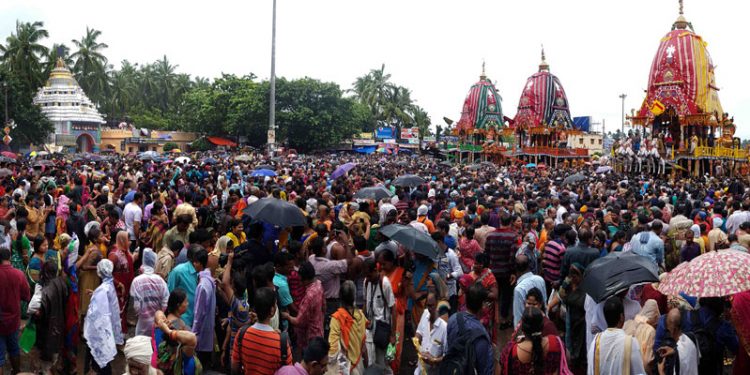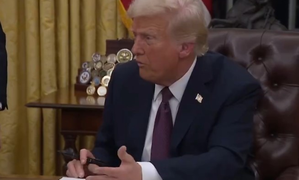Every year, Lord Jagannath sets out on a nine-day sojourn, on his chariot Nandighosh, to Gundicha temple along with His siblings, leaving behind His consort Goddess Sri Laxmi at Srimandir, their home. The siblings stay at Gundicha temple for a few days, enjoy delicious food and return on Bahuda. However, Sri Laxmi is jealous and annoyed that the Lord took His siblings, and not her, on the journey. She visits Gundicha temple on Hera Panchami Day and shows her annoyance by dismantling the Lord’s chariot.
Following the Bahuda Yatra, the return journey of the Lord and his siblings to their abode, Srimandir, there are other interesting rituals such as ‘Adhara Pana Lagi’ and ‘Suna Besha.’ Finally, in a ritual called ‘Niladri Bije,’ the deities return to Ratna Singhasana, their permanent throne in the sanctum sanctorum of Srimandir, and with this the Rath Yatra festival concludes.
Sunday POST talked to a few devotees and scholars to know more about some of the interesting rituals associated with the Rath Yatra.
Mahesh Sahu, a resident of Puri, visits Gundicha temple in the evening of Hera Panchami. He says, “When the Lords stay at Gundicha temple, I would like to have daily darshan till Bahuda. But it takes time to have a glimpse of the deities due to the crowds. And so, I visit the temple only on Hera Panchami day. Then I get to see the Lords at Adapa Mandap and witness the Hera Panchami ritual performed in the evening.”
Four days after Rath Yatra, Goddess Lakshmi sets out for the Gundicha temple from Srimandir on a palanquin to reunite with her consort. This is an elaborate ceremony where Subarna Mahalaxmi, Goddess Lakshmi’s idol, is taken out to Gundicha temple in a procession and the idols of Shri Jagannath and Mata Subarna Mahalakshmi are placed face-to-face for a while. The goddess expresses her anger over the Lord’s trip to Gundicha without her and urges Him to return to Srimandir. The Lord acknowledges her feelings and gives her agyaan mala to assure her about his return to their abode. When Goddess Laxmi comes out of Gundicha temple for the return journey, she sees the chariots. In a fit of anger, she dismantles Nandighosh, the Lord’s chariot. To represent this episode, a part of the Lord’s chariot is dismantled during Hera Panchami in a ritual called ‘Ratha bhanga.’ Then the Goddess’ procession returns to Srimandir.
“On the sixth day, all three chariots are turned towards south. This ritual is called ‘Dakshina moda’ after which the chariots are kept at the Nakachana Dwara, the eastern gate of Gundicha temple, so that they can roll straight towards Srimandir on the day of Bahuda,” explains Archita Panigrahi, a devotee from Puri.
Another three-day ritual observed at the Gundicha temple is the Rasalila of Lord Jagannath that begins on the sixth day. The Lord’s idol is escorted to the rasa mandap where hymns from Gita Govinda and ancient devotional couplets are sung in praise of the Lord. An interaction between Krishna and the gopis is enacted through hymns. Archita adds, “Earlier, these hymns were sung by devadasis. The devadasi system has been abolished now, hence the servitors sing the hymns.”
“Bahuda is identical to Rath Yatra, the only difference is that in Bahuda, the Lords return to their abode Srimandir from Gundicha,” says Prashanta Mishra, a scholar of the Jagannath cult.
In Bahuda, the three chariots halt for a while at the Mausima temple where the three deities are offered ‘Poda Pitha’, a favourite food of Lord Jagannath. After this ritual, the chariots of Balabhadra and Subhadra move straight to the Lions’ gate while Nandighosh, the chariot of Jagannath, halts in front of the King’s palace (Raja Nahara) where Goddess Lakshmi manages to get a glimpse of the chariot from the Chahani Mandapa to be reassured about His safe return. On Bahuda Yatra day, the deities remain in their respective chariots parked at the main temple, Singhadwara.
Another interesting ritual is the Suna Besha, which takes place on Asadha Ekadashi (as per Hindu almanac), when the three deities, on their respective chariots, are dressed in glittering golden attire. The ‘bhandara nikap’ priests (store in-charge) bring the gold ornaments from the ‘bhandara ghar’ guarded by armed police and temple officials and hand them over to the ‘puspalaka’ and ‘daitapati’ priests. During Suna Besha, Lord Jagannath and Balabhadra appear with hands and feet made of gold. Lord Jagannath holds a golden disc in his right hand and a silver conch in the left. Lord Balabhadra is seen holding a golden plough in his left hand and a golden mace in his right. Some of the ornaments used in Suna Besha include suna hasta (golden hand), payar (golden feet), mukuta (crown), golden mayur chandrika (golden peacock feather) and kundal (earring).
On the 11th day (ekadasi), the three deities are offered ‘adhara pana,’ a refreshing drink. ‘Adhara’ means ‘lip’ and ‘pana’ is a sweet scented drink made of milk, sugar, cheese, banana, camphor, nuts and black pepper. The ’pana’ is kept in huge cylindrical earthen pots reaching up to the deities’ lips. Each of the deities is offered three pots of ‘Adhara pana.’ After the ritual, the earthen pots are broken by the servitors so that the drink spills all over the chariot to satisfy spirits and ghouls.
Niladri Bije is the last ritual of the Rath Yatra festival observed on the 12th day. The scholar says, “During Niladri Bije, the deities are taken to the Ratna Singhasana in ‘goti pahandi’ procession. Unlike ‘dhadi pahandi,’ the idols are moved one after another in ‘goti pahandi.’ In other words, the second idol moves from the chariot only after the first reaches the destination.”
Before the idols enter the main temple, another ritual is observed as part of Niladri Bije. Goddess Laxmi shuts the temple gates, resentful that she was not taken on the sojourn to Gundicha temple. However, soon, she allows the Lord’s siblings and Sudarshana into the temple but prevents Jagannath from entering. To please His consort, Lord Jagannath offers the syrupy sweet rasagolla and finally manages to enter His abode, but not before a hot debate through the closed doors first. The servitors play out the argument between the holy couple from either side of the closed temple entrance gate before the quarrel is amicably resolved.
Himanshu Guru, OP






































